On an Apache reservation in Arizona, a toxic legacy and a mysterious history of chemical spraying
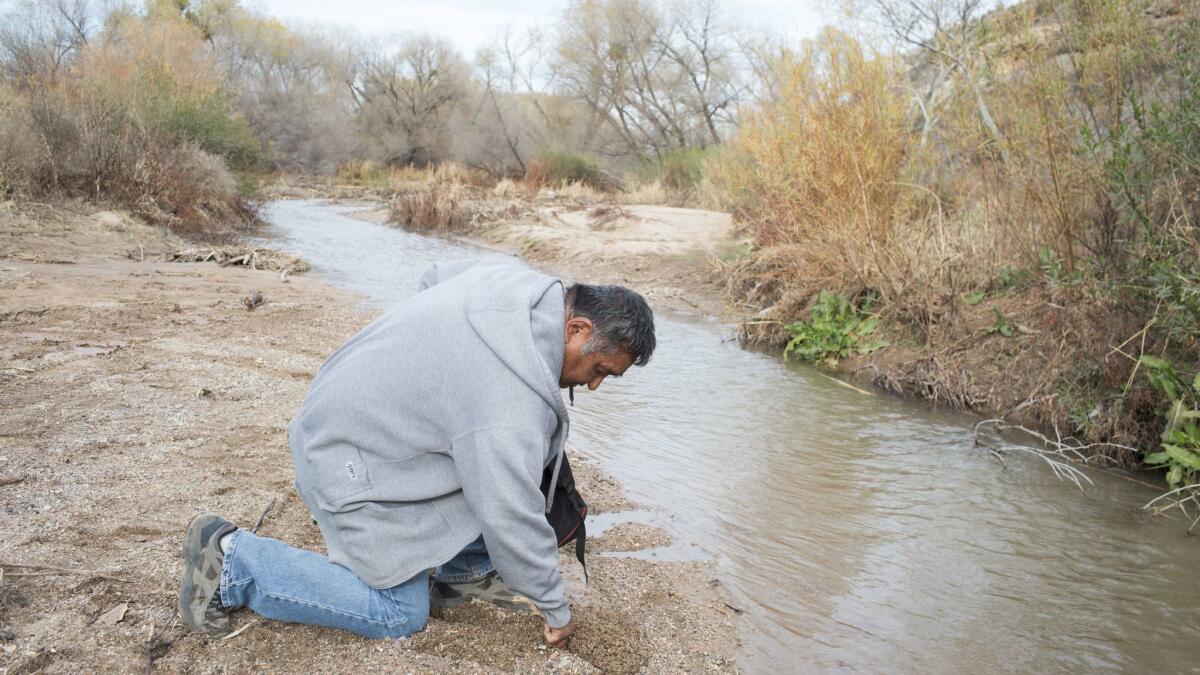
Reporting from San Carlos Apache Reservation — The sound always came first, a low buzz that grew and grew until it roared through the valley. Then the olive-colored plane appeared overhead, flying low. In its wake was a thick shower of oily droplets making a long, slow fall to the forested gullies below.
Kids on the Apache reservation back then chased the planes over gem-laden hills, past the flame-yellow salt cedars lining the banks of the Gila River. If they arrived ahead of the planes, they stood under the mysterious, oily rain, waiting for rainbows.
“We just played in it, drank the water with it in there, ate the food we hung out to dry covered in it,” said Mike Stevens, 62. “Didn’t know what it was.”
The planes were delivering a chemical cocktail with components similar to Agent Orange, the powerful herbicide that laid bare the jungles of Vietnam during the 1960s to allow American warplanes to peer into guerrilla encampments.
The compound, known as Silvex, was deployed as part of a little-known test effort from 1961 to 1972 to wipe out water-hungry vegetation on the San Carlos Apache Reservation, part of a larger effort by the federal government to protect scarce groundwater in the newly booming city of Phoenix.
The dioxin-laden herbicide was spread over a population of 10,000 for more than a decade. Now, half a century later, the federal Environmental Protection Agency is sending investigators to the reservation this month to find out exactly what was sprayed and what lingering effects it may have on one of the nation’s poorest Native American reservations.
“It’s in our air, our streams, our livestock,” said Charles Vargas, an activist on the reservation, 90 miles northeast of Phoenix. “This is fundamentally a crime, perpetrated on our people by the government, and no one’s ever had to answer for it.”
Tribal leaders declined to be interviewed, though they said the tribe had conducted its own extensive tests and found “no reason for concern.”
A small group of tribal members is hoping EPA investigators will help make public the extent of the spraying program and uncover what contamination, if any, remains.
Stevens, a retired truck driver, drives the rutted roads of the reservation and points to crumbling, abandoned houses of families who died out. One branch of the Thinkas are all dead, he said, as are the Bendles and the Cassas.
“Something took all of them,” Stevens said. “A couple people dying, OK. The whole family? You got to ask what they dropped on us.”
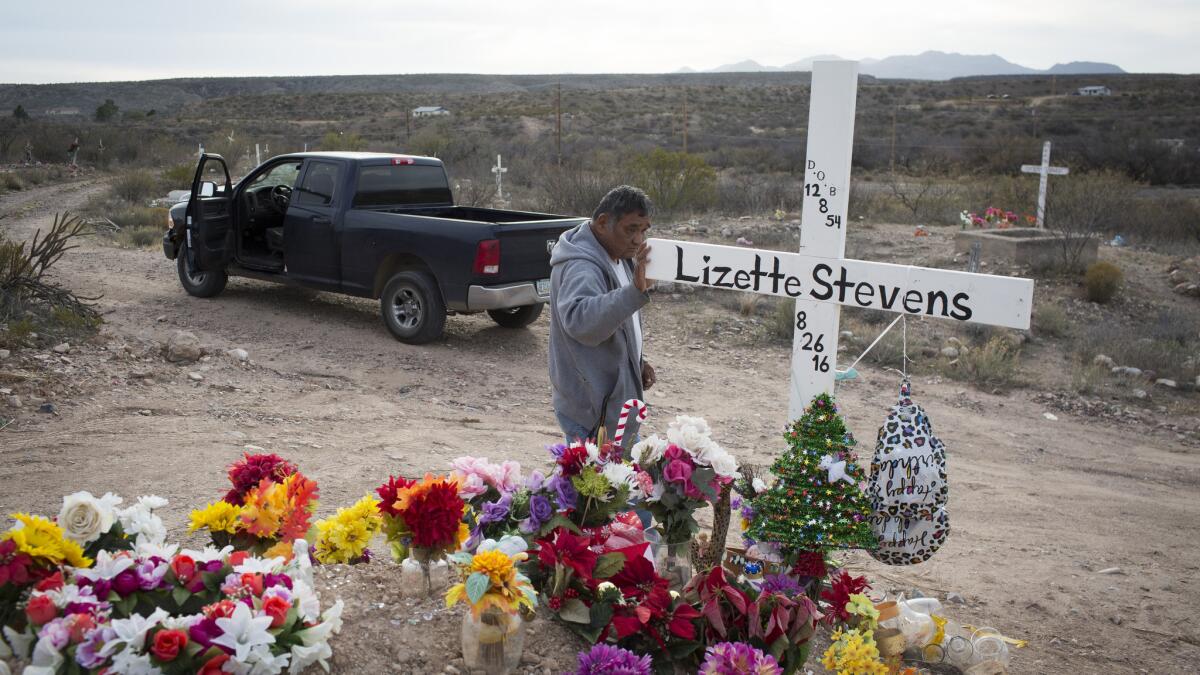
The shy girl with smooth skin lived near the river, and her family lived off its bounty. When the planes flew overhead, the chemicals covered the roof of her tight, tiny four-walled home, which she shared with her mother, grandmother, aunt and sister. It stuck to the dried meat and berries they hung outside, coated the clothing on wash lines.
No one told them what was falling from the sky. Day after day, the planes flew southeast to northwest to dump their payload on a 15-mile stretch of the Gila River next to their small home.
“She would cross the river and pick mushrooms, berries. All of it had stuff on it,” Stevens said, pointing to the river banks. “The flight path was right through here.”
In 1969, the flights ended. A few years later, Stevens returned to the San Carlos reservation after college and found that the shy girl with smooth skin was now a strong-willed woman named Lizette Edwards. They married.
Then, people on the reservation started to get sick. First, Edwards’ mother contracted breast cancer, as did her sister. Her aunt suffered from a central nervous system disorder that caused her to shake. All three died within a few years of each other in the 1980s and 1990s.
And it wasn’t just their family. Full branches of longtime San Carlos families simply seemed to drift away. First one member of the household would take ill, Stevens said, and the others seemed to wither with them. Some houses became nothing more than four walls and a sickbed. Children left for the cities, the older family members died out, and the houses still sit today, stripped of their worthwhile metals and abandoned.
::
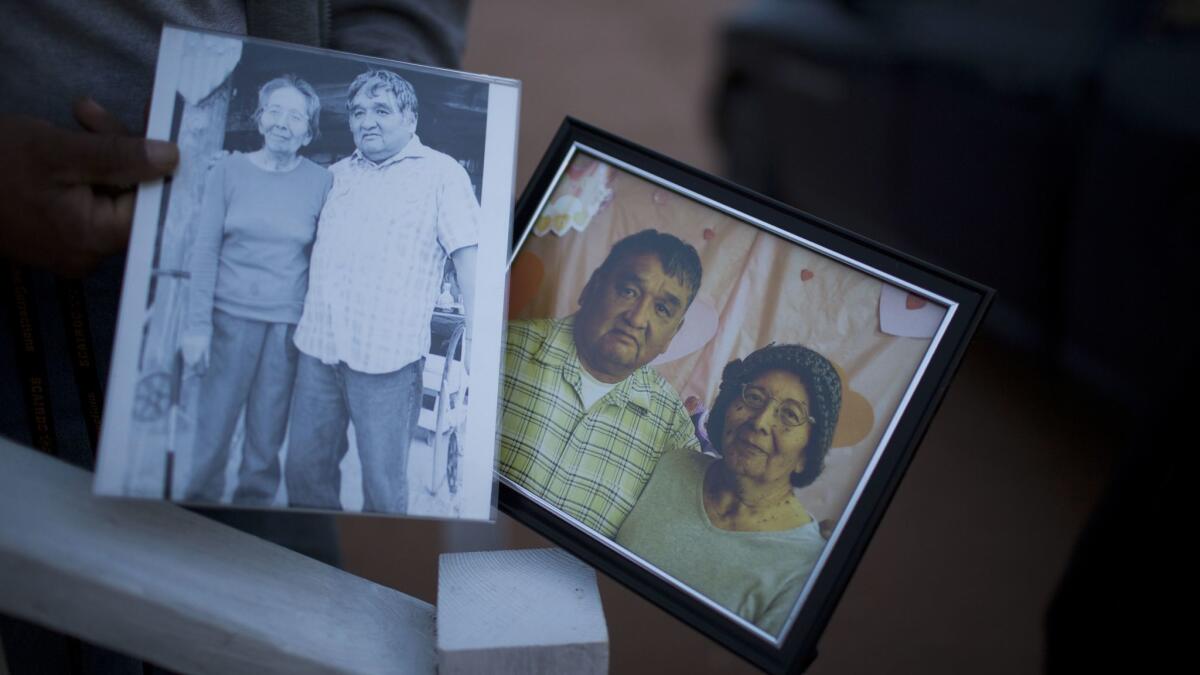
Determining what has sickened a person in the Pinal Mountains of eastern Arizona can be a complicated question. The area around San Carlos was already notoriously polluted. A smelting plant sent a fog of carcinogenic chemicals daily through the streets of the nearby town of Globe. Shuttered mining operations let metal-laden effluvia seep into the waterways. Radiation-contaminated air from 1950s nuclear testing in Nevada blew straight downwind.
Nor has the legacy of pollution here ended. In 2011, the EPA found that the tribe had long allowed excessive levels of arsenic and E. coli bacteria into the water supply while failing to monitor for nitrates, lead and copper.
In November, the agency reported that the tribe had not corrected any of the problems.
From its inception in 1874, the San Carlos Apache Reservation has been a harsh place to make a life. Early settlers called the area “Hell’s 40 Acres.”
Diabetes, obesity and cancer are rampant on the reservation, as they are among other tribes nationwide, something the U.S. Centers for Disease Control and Prevention wants to better understand. The cancer rate among Native American populations across the country increased from 1990 to 2009, even as the cancer rate among the general U.S. population shrank.
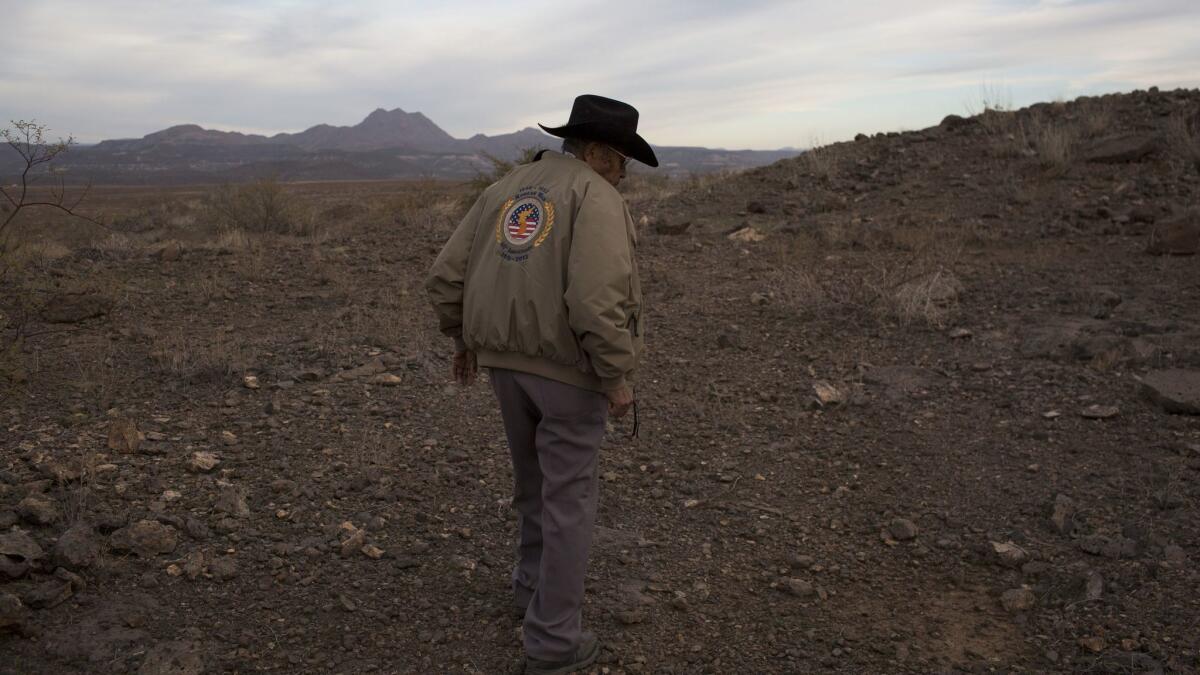
Despite all this, many tribe members say they are convinced that mining pollution, radiation and poor health habits couldn’t be responsible for so much sickness and death in one location.
The five Edwards women who shared the home near the river, the focus of the aerial spraying, are now buried in foot-tall mounds under tall white crosses above the riverbank, and only one of them succumbed to old age. Lizette, a voluble mother of three, was the latest: Stevens watched her shrink into herself as she suffered through pancreatic cancer, the skin tightening around her eyes and mouth until she appeared almost skeletal.
She died in August.
::
At the time the Silvex program began on San Carlos, another field trial was getting underway on the other side of the world — this one for Agent Orange, a hybrid containing the same hazardous compounds, 2,4-D and 2,4,5-T, sprayed at San Carlos. President Kennedy signed off on the use of the material to destroy the cover and cropland of communist guerrillas in North Vietnam in 1961.
The use of Agent Orange continued through the Vietnam War, but was halted abruptly in the late 1970s when researchers began to connect the presence of the noxious chemical dioxin to birth defects in lab animals.
More tests followed, and a national consensus against Agent Orange ended its use. In the following years, Vietnam veterans would begin to complain of a host of illnesses that they attributed to dioxin in their blood as a result of handling Agent Orange.
Soldiers filed a class-action lawsuit in 1979 against the herbicide manufacturers, including Dow Chemical Co. The suit was settled out of court in 1984 for $180 million, and payments since then have averaged $3,800 per veteran or their survivors. The plaintiff class is still expanding — in 2015, the Department of Veterans Affairs added 2,100 Air Force reservists to the eligible class of survivors.
Through the 1970s and 1980s, the environmental community began focusing on what had been the widespread use of Agent Orange-like herbicides across the U.S. Farmers had sprayed it on their fields to kill weeds; the U.S. Forest Service deployed it in forests in California and the Pacific Northwest.
Just outside the San Carlos reservation, in Globe, residents filed suit over a separate spraying program that had been conducted there, led by a woman, Billee Shoecraft, who was one of five people whose bodies had been directly doused with the aerial chemicals. The Globe plaintiffs settled with Dow Chemical in 1981 for an undisclosed amount, and Shoecraft, who wrote a book about her exposure called “Sue the Bastards!” later died of cancer.
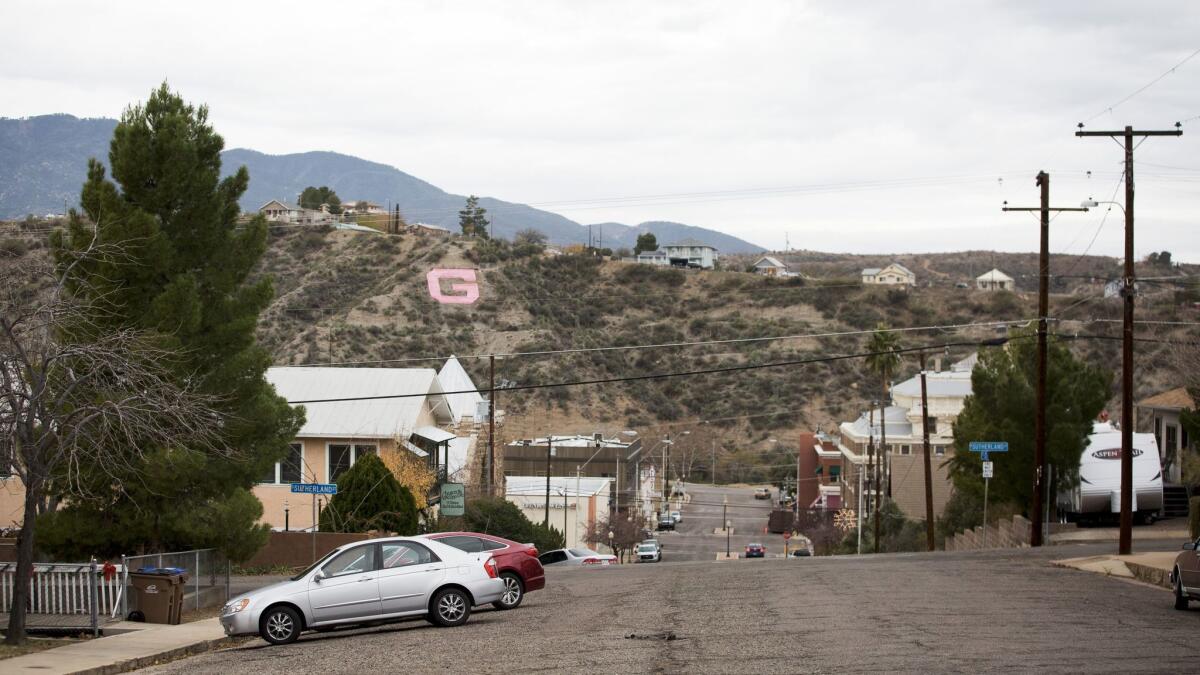
No one sued on the reservation — the tribal government itself had signed off on the spraying program. In 1987, the EPA tested the soil and water on San Carlos, selecting areas where the spraying compound was mixed and loaded onto planes. Twenty-four of 77 soil samples showed the presence of dioxin, but tests of fish and livestock tissue did not return any signs of contamination. No cleanup was ordered.
Then they found the barrels.
When the office of the federal Head Start preschool program on the reservation flooded in 2001, employees smelled something strange. In the building’s basement, once a U.S. Forest Service storage area, they found striped drums full of Silvex.
Hazardous-materials crews spent two weeks clearing the basement, then declared it safe. But the discovery of the barrels led a small band of tribal activists to begin asking why their tribal administration had not demanded compensation from the chemical’s producers or the government, as the citizens of Globe had done.
“They poisoned us,” said Michael Paul Hill, an activist and tribal attorney. “And [the tribe] won’t say why, or who did it. What we know is what we’ve learned on our own.”
Since the discovery of the barrels, tribal government leaders have refused to provide clear answers, according to residents who have sought help from the EPA.
In October, the federal agency announced that it had opened a new investigation into “possible herbicide contamination” at San Carlos. Agency officials in San Francisco notified Hill recently that investigators will be dispatched to the reservation later this month to conduct new soil tests.
Tribal officials have declined to discuss either the spraying program or the EPA inquiry in detail.
“We take the health and concerns of tribal members very seriously. When these concerns were raised, the San Carlos Apache Tribe’s EPA conducted extensive soil testing to determine if there was a danger to our members. The test results found no reason for concern,” tribal Chairman Terry Rambler said in a statement. “We welcome the federal EPA’s involvement and pledge to work with them on this effort.”
As for Stevens, he considers himself lucky. His parents had a covered porch, which kept the chemical compound off the food they dried outside. Families without porches, he said, haven’t fared as well.
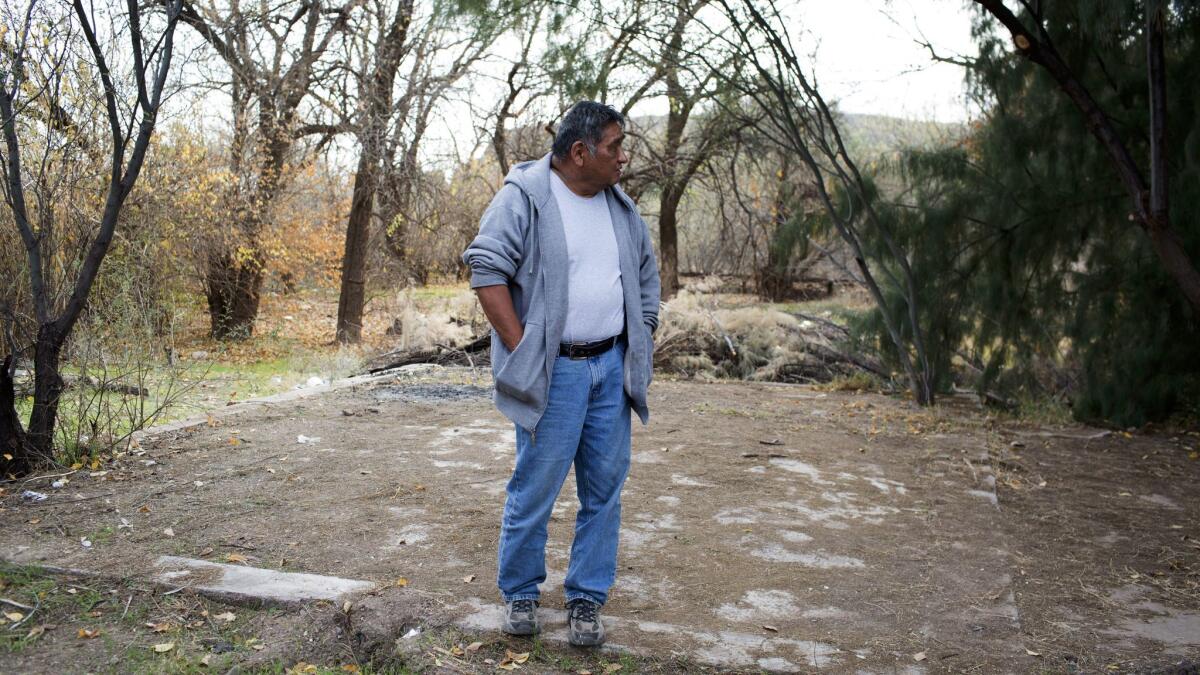
He stops at a bend in the Gila River. The trees hang lower here, forming a small, shaded canopy. Crumpled cans and an empty case of beer mark the recent presence of revelers. Then Stevens points to a 10-by-20-foot concrete slab buried in the earth.
It is the foundation of the home where his wife grew up.
“This is where it happened, spraying every day,” he said.
His blue Dodge Ram pulls out of the river bend and rumbles to a stop several miles north at his home.
A man who looks very much like a hunched, slender version of Stevens emerges from a rusted trailer. Ray Stevens, Mike’s father, was a Korean War veteran working as a fire spotter in a Bureau of Indian Affairs plane when he noticed the spraying program on his flights, and began to ask his superiors and tribal officials about it.
He was told that the project would remove “undesirable species” from the foliage without damaging the rest of the terrain.
“They told me, ‘Don’t ask anything else. You don’t got to know what’s being sprayed,’” Ray Stevens said.
Darkness falls. The younger Stevens gets back in the truck and steers toward home. On the wall there is a photo of Lizette on what would be her final birthday. She is gaunt but smiling.
“My girl,” he says.
Follow Nigel Duara on Twitter: @nigelduara
ALSO
How Faith Spotted Eagle became the first Native American to win an electoral vote for president
As extreme cold moves into Portland, the homeless die
Veterans came to North Dakota to protest a pipeline. But they also found healing and forgiveness
More to Read
Sign up for Essential California
The most important California stories and recommendations in your inbox every morning.
You may occasionally receive promotional content from the Los Angeles Times.











